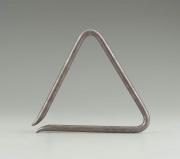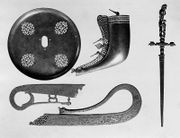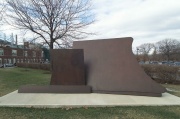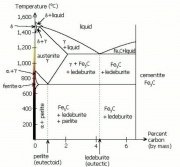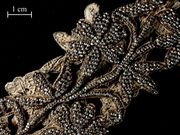Difference between revisions of "Steel"
| Line 9: | Line 9: | ||
{| class="wikitable" | {| class="wikitable" | ||
|- | |- | ||
| − | + | | | |
! Composition | ! Composition | ||
! Properties | ! Properties | ||
| Line 19: | Line 19: | ||
| ''Construction, automotive components, tools, and various industrial applications; they are often galvanized or electroplated with zinc for protection from rust'' | | ''Construction, automotive components, tools, and various industrial applications; they are often galvanized or electroplated with zinc for protection from rust'' | ||
|- | |- | ||
| − | + | ! | |
| Low carbon steel or mild steel: up to 3 % carbon | | Low carbon steel or mild steel: up to 3 % carbon | ||
| low cost and easy to form; excellent ductility, weldability, and malleability, | | low cost and easy to form; excellent ductility, weldability, and malleability, | ||
| ideal for structural applications and everyday products; machinery, pipes, wires and structural components. | | ideal for structural applications and everyday products; machinery, pipes, wires and structural components. | ||
|- | |- | ||
| − | + | ! | |
| Medium carbon steel:0.31-0.6% carbon and 0.31-1.6% magnesium | | Medium carbon steel:0.31-0.6% carbon and 0.31-1.6% magnesium | ||
| higher strength but lower ductility, making it harder to form than mild steel | | higher strength but lower ductility, making it harder to form than mild steel | ||
| automotive components and machinery parts; gears, cranks and machinery parts | | automotive components and machinery parts; gears, cranks and machinery parts | ||
|- | |- | ||
| − | + | ! | |
| High carbon steel: 0.61-1.50% carbon and 0.31-0.9% magnesium | | High carbon steel: 0.61-1.50% carbon and 0.31-0.9% magnesium | ||
| significantly harder and stronger; less ductile and more difficult to form or weld | | significantly harder and stronger; less ductile and more difficult to form or weld | ||
| Line 35: | Line 35: | ||
|- | |- | ||
|- | |- | ||
| − | + | | | |
! Added elements | ! Added elements | ||
! Properties | ! Properties | ||
| Line 45: | Line 45: | ||
| ''Girders, rails, rods, pipelines, and other applications where specific properties are needed'' | | ''Girders, rails, rods, pipelines, and other applications where specific properties are needed'' | ||
|- | |- | ||
| − | + | ! | |
| manganese, silicon, aluminum | | manganese, silicon, aluminum | ||
| − | | | + | | remove dissolved oxygen, sulfur and phosphorus |
| | | | ||
|- | |- | ||
| − | + | ! | |
| manganese, silicon, nickel, copper | | manganese, silicon, nickel, copper | ||
| − | | | + | | form solid solution of ferrite |
| | | | ||
|- | |- | ||
| − | + | ! | |
| chromium, vanadium, molybdenum, tungsten | | chromium, vanadium, molybdenum, tungsten | ||
| − | | | + | | form second phase carbides |
| | | | ||
|- | |- | ||
| − | + | ! | |
| nickel, copper | | nickel, copper | ||
| increase corrosion resistance | | increase corrosion resistance | ||
| | | | ||
|- | |- | ||
| − | + | ! | |
| manganese sulfide, lead, bismuth, selenium, tellurium | | manganese sulfide, lead, bismuth, selenium, tellurium | ||
| increase in machinability | | increase in machinability | ||
| | | | ||
|- | |- | ||
| − | + | ! | |
| molybdenum | | molybdenum | ||
| − | | | + | | increases embrittlement resistance |
| | | | ||
|- | |- | ||
| − | + | | | |
! Composition/Structure | ! Composition/Structure | ||
! Properties | ! Properties | ||
| Line 85: | Line 85: | ||
| ''Kitchenware, sheet metal, outdoor construction, and applications requiring resistance to harsh environments such as sheet metal and outdoor construction'' | | ''Kitchenware, sheet metal, outdoor construction, and applications requiring resistance to harsh environments such as sheet metal and outdoor construction'' | ||
|- | |- | ||
| − | + | ! | |
| Austenitic: face-centered cubic structure that is densely packed | | Austenitic: face-centered cubic structure that is densely packed | ||
| non-magnetic and the most common stainless steel | | non-magnetic and the most common stainless steel | ||
| often used in kitchen appliances. | | often used in kitchen appliances. | ||
|- | |- | ||
| − | + | ! | |
| Ferritic: body-centered cubic structure that is loosely packed | | Ferritic: body-centered cubic structure that is loosely packed | ||
| magnetic and less expensive than most stainless steel | | magnetic and less expensive than most stainless steel | ||
| | | | ||
|- | |- | ||
| − | + | ! | |
| Martensitic: body-centered tetragonal structure | | Martensitic: body-centered tetragonal structure | ||
| greater strength but less resistance to oxidation than most stainless steel | | greater strength but less resistance to oxidation than most stainless steel | ||
| used in pliers, cutlery and medical instruments | | used in pliers, cutlery and medical instruments | ||
|- | |- | ||
| − | + | | | |
! Processing / Series identification | ! Processing / Series identification | ||
! Properties | ! Properties | ||
| Line 110: | Line 110: | ||
| ''Cutting tools, dies, molds, and other applications requiring high strength and wear resistance'' | | ''Cutting tools, dies, molds, and other applications requiring high strength and wear resistance'' | ||
|- | |- | ||
| − | + | ! | |
| Water-hardening (series W) | | Water-hardening (series W) | ||
| high hardness and lower cost but tend to be brittle and unsuited for high temperatures | | high hardness and lower cost but tend to be brittle and unsuited for high temperatures | ||
| drills, cutlery | | drills, cutlery | ||
|- | |- | ||
| − | + | ! | |
| Cold Work: Air hardening (series A); oil-hardening (series O) | | Cold Work: Air hardening (series A); oil-hardening (series O) | ||
| have high wear resistance and toughness | | have high wear resistance and toughness | ||
| many types of dies, bushings, gauges; knives; cutting tools, woodworking tools | | many types of dies, bushings, gauges; knives; cutting tools, woodworking tools | ||
|- | |- | ||
| − | + | ! | |
| Hot-work (series H) | | Hot-work (series H) | ||
| retain their hardness and strength at high temperatures | | retain their hardness and strength at high temperatures | ||
| saw blades, drill bits router bits | | saw blades, drill bits router bits | ||
|- | |- | ||
| − | + | ! | |
| Shock resisting (series S) | | Shock resisting (series S) | ||
| effective at low and high temperature but are less corrosion resistant | | effective at low and high temperature but are less corrosion resistant | ||
Revision as of 07:46, 20 March 2025
Description
A high-strength Iron alloy containing not more than 2% Carbon. Steel may also contain small amounts of Phosphorus, Sulfur, Manganese, Silicon, Aluminum, Titanium, Copper, Molybdenum, and Nickel. Small amounts of steel were made into swords and cutting implements in antiquity in Japan and India. From 1855-1875, Bessemer, Kelly, Thomas, Gilchrist, Mushet and others developed manufacturing procedures to quickly and consistently produce good quality steel from pig iron. Steel, with its strength, resilience, hardness and formability was being produced in quantities of 25 million tons a year by the end of the 19th century. It was primarily used for construction of ships, bridges, building and skyscrapers. Steel was also used for smaller items, such as knives, weapons, decoration and architectural components (grilles, doors, windows, roofing, gutters, brackets, wire cloth, cables and hardware).
| Composition | Properties | Applications | |
|---|---|---|---|
| Carbon steel | Primarily iron and carbon, with carbon content typically up to 2.5%. | Most common type of steel making up 90% of steel production; easily welded or machined; high strength and hardness; more prone to rust and corrosion. | Construction, automotive components, tools, and various industrial applications; they are often galvanized or electroplated with zinc for protection from rust |
| Low carbon steel or mild steel: up to 3 % carbon | low cost and easy to form; excellent ductility, weldability, and malleability, | ideal for structural applications and everyday products; machinery, pipes, wires and structural components. | |
| Medium carbon steel:0.31-0.6% carbon and 0.31-1.6% magnesium | higher strength but lower ductility, making it harder to form than mild steel | automotive components and machinery parts; gears, cranks and machinery parts | |
| High carbon steel: 0.61-1.50% carbon and 0.31-0.9% magnesium | significantly harder and stronger; less ductile and more difficult to form or weld | commonly utilized in cutting tools and high-strength wires; steel plates and bars | |
| Added elements | Properties | Applications | |
| Alloy steel | Carbon steel with alloyed elements | More expensive; alloys add enhanced strength, ductility, corrosion resistance, and machinability | Girders, rails, rods, pipelines, and other applications where specific properties are needed |
| manganese, silicon, aluminum | remove dissolved oxygen, sulfur and phosphorus | ||
| manganese, silicon, nickel, copper | form solid solution of ferrite | ||
| chromium, vanadium, molybdenum, tungsten | form second phase carbides | ||
| nickel, copper | increase corrosion resistance | ||
| manganese sulfide, lead, bismuth, selenium, tellurium | increase in machinability | ||
| molybdenum | increases embrittlement resistance | ||
| Composition/Structure | Properties | Applications | |
| Stainless steel | Carbon steel with a minimum of 10.5% chromium, which forms a protective oxide layer, preventing rust and corrosion | The added chromium protects the metal from oxidation and corrosion and provides shiny finish, and good strength | Kitchenware, sheet metal, outdoor construction, and applications requiring resistance to harsh environments such as sheet metal and outdoor construction |
| Austenitic: face-centered cubic structure that is densely packed | non-magnetic and the most common stainless steel | often used in kitchen appliances. | |
| Ferritic: body-centered cubic structure that is loosely packed | magnetic and less expensive than most stainless steel | ||
| Martensitic: body-centered tetragonal structure | greater strength but less resistance to oxidation than most stainless steel | used in pliers, cutlery and medical instruments | |
| Processing / Series identification | Properties | Applications | |
| Tool steel | Carbon and Alloy steels containing elements like cobalt, molybdenum, tungsten, and vanadium for enhanced hardness and wear resistance | High hardness, durability, and ability to hold a sharp edge | Cutting tools, dies, molds, and other applications requiring high strength and wear resistance |
| Water-hardening (series W) | high hardness and lower cost but tend to be brittle and unsuited for high temperatures | drills, cutlery | |
| Cold Work: Air hardening (series A); oil-hardening (series O) | have high wear resistance and toughness | many types of dies, bushings, gauges; knives; cutting tools, woodworking tools | |
| Hot-work (series H) | retain their hardness and strength at high temperatures | saw blades, drill bits router bits | |
| Shock resisting (series S) | effective at low and high temperature but are less corrosion resistant | chisels, breakers, hammers, and neumatic tools |
Synonyms and Related Terms
acier (Fr.); Stahl (Deut.); acero (Esp.); staal (Ned.); aço (Port.)
Brand names: See also Cor-Ten,
Risks
Inhalation of dust or metal fumes is dangerous.
Resources and Citations
- G.S.Brady, Materials Handbook, McGraw-Hill Book Co., New York, 1971 Comment: p. 771
- Ralph Mayer, A Dictionary of Art Terms and Techniques, Harper and Row Publishers, New York, 1969 (also 1945 printing)
- Thomas C. Jester (ed.), Twentieth-Century Building Materials, McGraw-Hill Companies, Washington DC, 1995
- Tom Rowland, Noel Riley, A-Z Guide to Cleaning, Conserving and Repairing Antiques, Constable and Co., Ltd., London, 1981
- Michael McCann, Artist Beware, Watson-Guptill Publications, New York City, 1979
- Dictionary of Building Preservation, Ward Bucher, ed., John Wiley & Sons, Inc., New York City, 1996
- Ivan Amato, Stuff: The Materials the World is Made of, Avon Books, New York, 1997 Comment: p. 46
- Wikipedia: Steel Accessed March 2025
